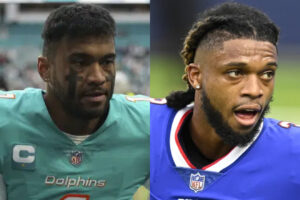
Football is loved by people all over the world, but to some, this game is more than just a sport.
Professional football players commit their lives to a sport that spectators find entertaining. It also brings in billions of dollars every year for the National Football League. However, a career in this game poses many risks that can cause severe physical harm to those who play it.
In recent high-profile incidents, NFL players have suffered from injuries that have the nation concerned for their physical health.
Beginning in September, Miami Dolphins quarterback Tua Tagovailoa suffered multiple head injuries, resulting in an end to his 2022-2023 season.
Tagovailoa’s initial concussion was caused by taking a hard blow to the head when he hit the ground after being tackled, but his condition grew worse when he was put back into the game and hit his head again after a similar sack.
Concussions are not uncommon in football and can cause long-term effects such as memory loss, personality changes, sleep disturbances and other psychological problems.
James Dorsey, a third-year business administration student and former high school football player, believes that the NFL could do a better job at protecting its athletes.
“The NFL has put stricter rules in place to protect players from head injuries such as bringing in new helmets,” Dorsey said. “However, concussion protocol has to be enforced, or changed, due to the frequency of concussions and the ‘play through it’ mentality that comes with playing football at a high level.”
Football players are not limited to just head injuries, but near-deadly injuries as well.
Damar Hamlin, a 24-year-old safety for the Buffalo Bills, experienced a life-threatening emergency on Jan. 2 against the Cincinnati Bengals.
Almost immediately after being blocked by one of his opponents, Hamlin collapsed and went into cardiac arrest. Medical personnel revived him through cardiopulmonary resuscitation, commonly known as CPR, on the field before paramedics arrived, He is now recovering.
Although this was a rare occurrence, it shows that there is still more to learn about the severe injuries that can result from playing football.
After playing as quarterback for the Clemson Tigers for four years, Florida A&M University football coach Willie Simmons shares a different look on this topic of interest.
“I think the NFL has a responsibility to protect its athletes from short-term and long-term injuries,” Simmons said. “and I feel the National Football League Players Association has to continue to fight for post-career health care benefits for its current and former or retired players.”
The NFLPA has called for the NFL to make small but necessary changes for the safety of athletes, but the NFL has not shown any concern.
For example, research shows that majority of physical injuries in the NFL result from playing on slit film turf. Seven NFL teams currently have slit film turf in their stadiums and leadership has written a letter to the NFL for an immediate removal on these fields and ban moving forward altogether.
“The NFL has not only refused to mandate this change immediately,” JC Tretter, the author of “NFL Player Health & Safety: Lies Beneath the Surface,” said. “but they have also refused to commit to mandating a change away from slit film in the future at all.”
Football fans believe in making the game safer for athletes so that they may play the game they love without suffering from preventable injuries.
Now, they just wait on the NFL to make it happen.